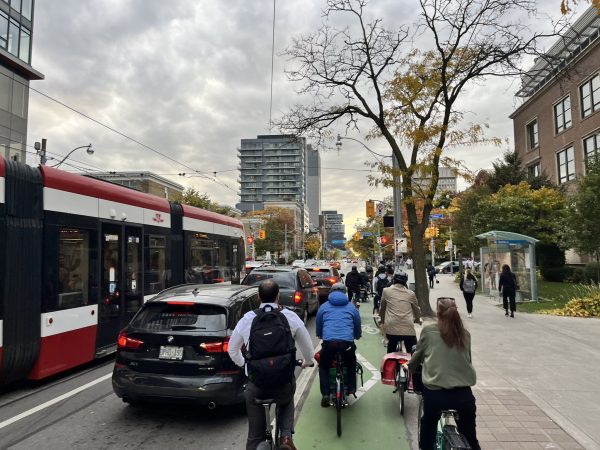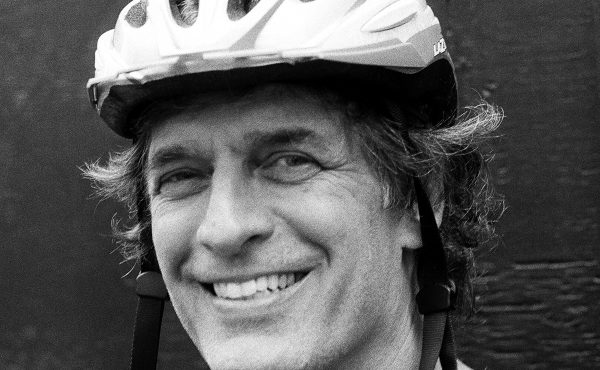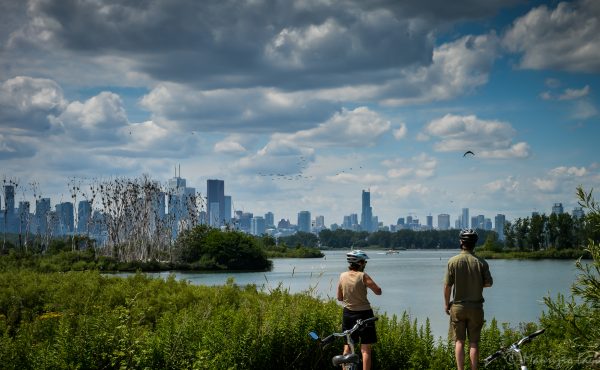A lot of good reasons against Ontario premier Doug Ford’s plans to not only block many planned bike lanes but rip up some existing one have been put forward, based on safety and travel efficiency, and even main street vitality. But there’s another angle too, and that’s how it messes up Toronto’s planning for adding housing for thousands of new residents (intensification, it should be noted, that is mandated by the provincial government).
In 2021, Toronto abolished car parking minimums for most new developments. The many new tall multi-unit buildings going up in and around downtown and along arterial roads are able to provide parking based solely on what the developers think the market demands (although there are now maximum numbers). In many cases, that means no parking at all. In fact, some projects that were approved under previous zoning that required a certain amount of parking are going back through the planning process to get those parking spaces reduced or removed in line with the new zoning.
The logic is in part, simply, that there is no room in and around downtown Toronto for more cars. Opening up curb lanes on a couple of roads won’t make a significant difference. Central Toronto has reached its motor vehicle saturation point. On the other hand, those living in and around downtown Toronto can walk or cycle to many destinations, and have easy access to rapid transit to more distant ones. And, unlike cars, there is still room to expand the number of people using those transportation options (though perhaps less so when it comes to commuting via transit).
Recognizing this potential, the City has also changed its zoning to require a lot more bike parking spaces in new multi-unit buildings, at the rate of almost one long-term space per unit, plus some short-term (visitor) spaces, often resulting in hundreds of bike parking spaces in new projects (which, of course, take up far less room than the equivalent number of car parking spaces would have).

In other words, the transportation element of Toronto’s intensification strategy is specifically that people moving into new condos and apartments in and around downtown Toronto will use bicycles to get around instead of cars. It would be impossible to accommodate all those additional people if they all wanted to drive.
But of course getting all those downtown residents to rely on bikes can only work if they are comfortable cycling on the streets. In congested central Toronto, that requires safe, separated bike lanes. And the bike lanes that Doug Ford is targeting for removal – Bloor, University, and Yonge – are specifically ones that would be relied on by residents of the new tall residential buildings going up in or near downtown. Additional future bike lanes that would be blocked by the new legislation – such as ones on Yonge south of Bloor – are also ones that would specifically serve the new multi-residential buildings that will be chock-full of bike parking but lacking any car parking.
The province wants Toronto to absorb more residents, and Toronto is doing so in part by intensifying the central parts of the city where new residents can access destinations such as workplaces, services, and entertainment without needing a car. Cycling plays a key role in making this possible, enabling access to destinations that are too far to walk to conveniently, but not far enough to make using Toronto’s increasingly unreliable transit worthwhile. The City’s new parking requirements for multi-residential projects are specifically designed to enable cycling to play this essential role in the transportation network instead of cars. By attacking downtown bike lanes, Doug Ford is hamstringing Toronto’s deliberate strategy to create living space for more residents without making its streets even more hopelessly clogged with cars.
Photo by Adam Scott






3 comments
In 2012, Mayor Rob Ford (and Councillor Doug Ford) spent $300,000 to remove bicycle lanes from Jarvis Street. Removing the lanes saved the motorists just “2 minutes”.
Today, Premier Doug Ford (and Ford Nation) wants to remove bicycle lanes from streets that are under City of Toronto jurisdiction.
The Ford family (and Ford Nation) are automobile god disciples. Doug Ford still wants to be Mayor of Toronto, even though he lost the 2014 election against John Tory.
Acknowledging space restrictions and the need for diversified transportation modes, many people who are 55+ and/or with mobility issues are not going to be hopping on bicycles in sub zero temperatures. There are actually quite of few of us at any given time, and for those who are younger and cannot conceive of this state of being (because no one can when they aren’t experiencing it): one day, you will be part of that demographic. Further, it’s worth remembering that literally every facet of living in a city, from goods/services we enjoy, to food, water, and energy we consume, to the shelter we live in, to every piece of municipal infrastructure we use (including bike lanes) is possible because vehicles are driven on roads,
removing bike lanes from Bloor & preventing future bike lanes is just good for the rich Etobicoke people who vote for Ford